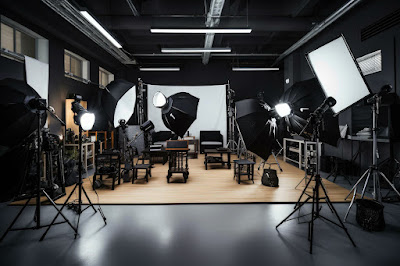Buy Books on Studio set up
Portrait photography, including headshot photography, is an art form that requires both technical expertise and a keen eye for detail. Photographic studios provide the ideal environment for capturing stunning portraits, while professional photography techniques ensure that the final images resonate with viewers. Whether you are a budding photographer or someone looking to update your professional image, understanding these elements can help you appreciate the artistry behind portrait photography.
Headshot photography and portrait photography are two
distinct styles within the realm of photography, each serving different
purposes and conveying unique messages. Understanding the key differences
between them can help individuals choose the right type of image for their
needs.
Purpose and Use
Headshot Photography: Headshots are typically used in
professional contexts, such as LinkedIn profiles, business cards, and official
websites. They aim to present a polished, approachable image of the subject,
often focusing on the face and shoulders. The goal is to convey professionalism
and trustworthiness, making a strong first impression in business or acting
contexts.
Portrait Photography: Portraits, on the other hand,
are more expressive and artistic. They can be used in a variety of settings,
including magazines, blogs, and personal collections. Portraits aim to capture
the essence of the subject, often telling a story or conveying a deeper
emotional narrative. They can include a wider range of moods and settings,
showcasing the subject in various poses and environments.
Composition and Style
The composition and style of headshots and portraits
also differ significantly.
Headshot Composition: Headshots are usually tightly
cropped to focus primarily on the subject's face, with minimal distractions in
the background. They often feature straightforward lighting that minimizes
shadows, creating a clean and professional look. The subject typically
maintains direct eye contact with the camera, projecting confidence and
approachability.
Portrait Composition: Portraits allow for more
creative freedom. They can include full-body shots or environmental elements
that enrich the storytelling aspect of the image. Portraits often utilize
dramatic lighting and varied backgrounds to create mood and depth, allowing for
a broader range of expressions and interactions with the environment. This
artistic approach helps convey the subject's personality and narrative more
effectively.
Mood and Expression
Headshot Mood: Professional headshots generally aim
for a relaxed and friendly feel, often featuring the subject smiling. This is
intended to communicate trust and approachability, which are essential in professional
settings.
Portrait Mood: Portraits can evoke a wide array of
emotions, from joy to melancholy. They often explore deeper narratives and can
depict the subject engaged in activities or looking away from the camera,
adding layers to the story being told. This flexibility allows for a richer
emotional connection with the viewer.
Lighting and Environment
Headshot Lighting: Headshots typically use soft,
diffused lighting to create a flattering appearance with minimal shadows. The
background is often neutral or blurred to keep the focus on the subject's face.
The primary distinction between headshot and portrait photography lies in their intended use.
The emotional tone conveyed in headshots and portraits
also varies.
Lighting and the choice of environment further
differentiate these two styles.
Portrait Lighting: In contrast, portraits may employ dramatic lighting techniques, incorporating shadows and highlights to enhance the artistic quality of the image. The environment plays a crucial role, as it can complement the subject's story, adding context and depth to the photograph.
 |
| Clasic Portrait |
 |
| Professional Head Shot |
The Role of Photographic Studios
Photographic studios play a vital role in the portrait photography process. They provide a controlled environment where lighting and backgrounds can be manipulated to achieve the desired effect. Many professional photographers operate out of dedicated portrait studios, equipped with various backdrops, props, and lighting equipment designed specifically for portrait work.In a studio setting, photographers can create a consistent look across their portfolio, allowing for creative experimentation with different styles and techniques. The use of studio lighting can enhance the subject's features, creating depth and dimension in the final images.

Modern Photography Studio

Professional Photography Techniques
Professional photography involves a combination of technical skill and artistic vision. Photographers must understand camera settings, lighting techniques, and composition to create compelling portraits.Some essential techniques include:
Lighting: Mastering natural and artificial lighting is crucial. Soft,
diffused light often works best for flattering portraits, while harsh lighting
can create unflattering shadows.
Composition: The arrangement of elements within the frame can
significantly impact the portrait's effectiveness. Techniques such as the rule
of thirds can guide photographers in creating balanced and engaging images.
Post-Processing: After capturing the images, professional photographers
often use editing software to enhance the final product. This can include
retouching skin blemishes, adjusting colors, and cropping for better
composition.








2 Comments
Excellent Presentation and posses extraordinary skillet to demonstrate the grammar of potrait photography..which is rarely available
ReplyDeletethank you so very much for your insight
Delete